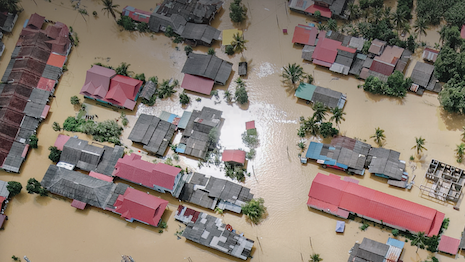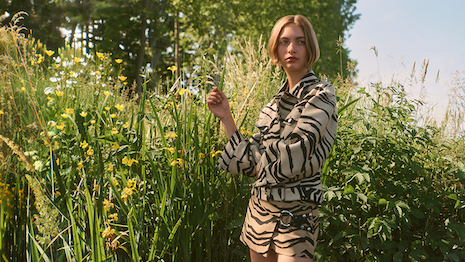 Due to a heavy reliance on raw materials, haute couture and prestige brands stand at a particularly high risk of losses in the face of the catastrophe unfolding. Image credit: Cornell University
Due to a heavy reliance on raw materials, haute couture and prestige brands stand at a particularly high risk of losses in the face of the catastrophe unfolding. Image credit: Cornell University
As extreme weather events increase, seas rise and habitat destruction intensifies, apparel production is suffering alongside the planet.
Due to luxury fashion being especially reliant on raw materials, the sector finds itself particularly at risk due to climate change. With many reports putting the financial cost of “business as usual” in the billions, it is clear that the industry can either choose to do nothing and pay dearly, or adapt – many brands are opting for the latter.
What is at stake
According to recent research from data gathering platform Statista, right now the luxury fashion industry is worth $111.5 billion in 2023.
By 2028, that number is expected to grow by 18.15 percent, reaching $131.7 billion, an increase of $20.2 billion in just five years. Using those calculations, this total will stand at $145.3 billion in 2030.
Cornell University’s Global Labor Institute and investment firm Schroders published a report on Wednesday, Sept. 13, entitled “Higher Ground?”
The findings indicate that 2030 will be the year that the fashion industry’s four most vital production countries – Bangladesh, Pakistan, Vietnam and Cambodia – which account for 18 percent of the world’s apparel exports – will lose $65 billion in earnings and 958,000 jobs directly due to climate change.
Cornell breaks down how fashion is at risk
This loss is equal to 44.7 percent of the global luxury sector’s total projected worth for that same year.
Based on analysis of climate scenarios known as Representative Concentration Pathways and Shared Socioeconomic Pathways, as well as climate change models granted by the Intergovernmental Panel on Climate Change, the findings from “Higher Ground?” are based on what will happen if the world does nothing to adapt. Unsurprisingly, this would result in a doomsday of sorts for all involved.
The human-caused emergency occurring around the planet is not just causing desertification – the classic scenes that children are taught about, where lush landscapes become barren and hot as temperatures increase – but also increased rains, worsened storms, warming oceans and, among other disasters, mass die-offs of essential species like pollinating bees.
How will this affect luxury fashion? Though it is a complex issue, there are some simple risks to keep in mind.
As we continue to see extreme weather events happening across North America and around the world, we want to re-share our Climate Change and Pollinators brochure. Download at https://t.co/BFuBRmU3lG pic.twitter.com/Aou3lPYJkl
— Pollinator Partnership (@Pollinators) August 21, 2023
Dying pollinators means struggling plants of all kinds, including those that eventually get turned into fine clothing. Due to the nature of luxury and its emphasis on raw materials, this is especially something that companies should be conscious of when deciding which environmental causes to support or which emergencies they deem necessary to plan for.
Warming oceans spell the slowing down of carbon exchanges between surface waters and deep waters, meaning that the sea is acidifying and therefore destabilizing the entire system. Since the blue part of Earth regulates weather, keeps seasons stable and controls how extreme storms will be, it is obvious that damaging the ocean could cause major disruptions across the supply chain.
Heavier rains and intensified natural events are also already making business difficult, not to mention putting vital workers in harm’s way, washing away entire towns, flattening cities and leading to growing death tolls.
Business of Fashion's chief sustainability correspondent Sarah Kent moderates a panel on climate resilience
“Flooding and extreme heat pose a significant risk to every constituency in global apparel production – workers, manufacturers, regulators, investors and brands themselves,” said Jason Judd, executive director at Global Labor Institute, in a statement.
Just last year, unusually powerful monsoons affected 40 percent of Pakistan’s cotton yield between June 2022 and September 2022, according to the Government of Pakistan.
The impact being made on an individual level in every country and specifically within the fashion industry is not to be ignored, with 82 percent of top business executives stating that they are personally affected by climate change events already (see story).
It will continue to get harder for organizations at every level, with raw sources depleting, pandemics happening more often due to habitat fragmentation – which increases exposure to zoonotic diseases – and heat making factories too dangerous to operate in. This summer has been deemed the hottest on record by NASA's Goddard Institute of Space Studies, just as most summers have been as of late, showcasing the formation of a dangerous pattern.
Earth just had its hottest three months on record confirms @WMO & @CopernicusECMWF
🌡️ Every increment of warming results in rapidly escalating compounding & cascading hazards & related losses & damages.@WMO News 🔗 https://t.co/mmmFRBQ0qx#IPCC Report🔗 https://t.co/zAMzd12TGF pic.twitter.com/J1OaIuakLK
— IPCC (@IPCC_CH) September 6, 2023
“Summer 2023’s record-setting temperatures aren’t just a set of numbers – they result in dire real-world consequences,” said Bill Nelson, an administrator at NASA, in a statement.
“From sweltering temperatures in Arizona and across the country, to wildfires across Canada and extreme flooding in Europe and Asia, extreme weather is threatening lives and livelihoods around the world.”
What is being done
The crises that are caused by the larger environmental emergency are plentiful, but luxury labels are taking mitigation approaches.
French fashion house Louis Vuitton is addressing conservation in order to green its own supply chain and materials used, working with nonprofits and indigenous people in Australia (see story).
#LouisVuitton & People For Wildlife. As part of a commitment to preserve natural resources, the partnership will maintain and improve biodiversity in a 400,000-hectare area in Australia. Learn more at https://t.co/GjtC20eGQR#LouisVuitton pic.twitter.com/upAIDXy8YF
— Louis Vuitton (@LouisVuitton) January 31, 2023
However, approaches like these may not be enough to protect assets as climate change gets worse.
“These issues are material risks for brands, retailers and their investors, but adaptation is not being factored into risk planning because the industry and regulators are focused on mitigation measures,” said Angus Bauer, head of sustainable investment research at Schroders, in a statement.
Some luxury brands are touting education as a way to adapt (see story), drawing on the widely available resources to help companies shift gears in a way that suits the new landscape. Names like Swiss luxury conglomerate Kering coming out with their own reports, like the 2015 “Climate Change Risks for Luxury Fashion,” but the government is lending a hand in building industry knowledge.
Holt Renfrew has been scrutinizing its own sustainability for a decade, revealing all in a new video
The United Nations has even recently published research for the use of all, revealing how businesses can identify low carbon sources of animal fibers and humanmade materials, responding to the growing interest in sustainable fabrics.
Leather, especially, is under extra scrutiny. As humans chop down forests, it not only harms the species that live there but accelerates the warming of the planet itself.
In areas where rainforest is being cleared for the beef industry, fire is often used to accelerate the process, which releases the carbon dioxide that the trees hold within them after absorbing from the atmosphere. This creates a kind of CO2 bomb, costing the world an oxygen maker and greenhouse gas capturer while adding a warming substance back into the ozone at the same time.
Luxury, known for leather goods and ateliers that work with the material, has been slowly leaning away from the commodity.
Biology is opening up a multi-trillion dollar market opportunity in materials. And mycelium, with its uniquely customizable structure, is the key to unlocking it.
MycoWorks CEO Matt Scullin joins our podcast to talk all things mycelium. Full episode: https://t.co/bhRmzYKh6r 🎙 pic.twitter.com/jbop7BIEJR
— MycoWorks (@MycoWorksInc) June 13, 2023
For decades it has been publicized that the leather industry is not a byproduct of beef, but rather a business of its own, which is why animals that have popular skins for apparel are slaughtered but rarely end up on the plate, like alligators, ostriches and snakes.
Brands like British fashion house Stella McCartney have been championing fruit alternatives since the early 2000s as a way of staying away from the system (see story), but other heritage brands are jumping on board and stepping into the future (see story).
As the planet becomes less livable and society nears the tipping point where warming will be irreversible, consumers are at the very least demanding transparency from those who make the products that they buy.
 There is hope in adapting to climate change, as brands like Stella McCartney demonstrate with every viral fashion show and release of sought-after sustainable wares. Image credit: Stella McCartney
There is hope in adapting to climate change, as brands like Stella McCartney demonstrate with every viral fashion show and release of sought-after sustainable wares. Image credit: Stella McCartney
The emergency taking place and the necessary publicity around it is making those outside of environmental fields more informed customers.
So, whether luxury fashion is simply honest about pollutants, embraces secondhand creations, overhauls materials, builds outside of flooding zones, invests in wilderness protection or reorganizes to put sustainability leaders in the decision-making rooms, businesses that lean into adaptation rather than small mitigation projects are well-positioned for whatever future lies ahead, all things considered.